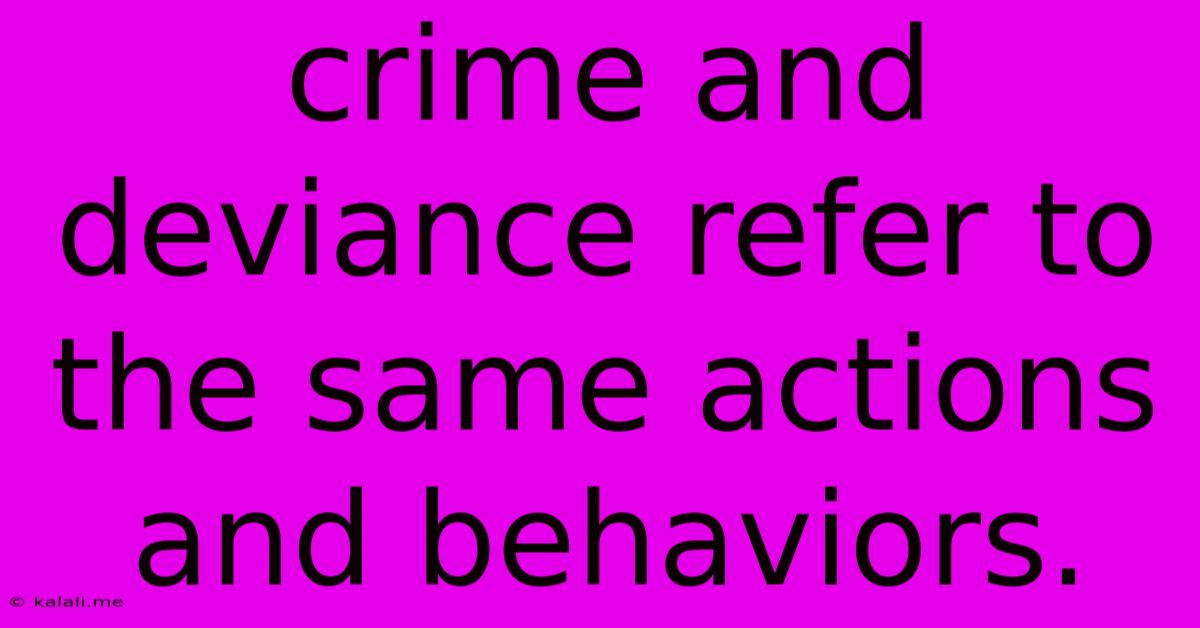Crime And Deviance Refer To The Same Actions And Behaviors.
Kalali
Jun 14, 2025 · 3 min read

Table of Contents
Crime and Deviance: Are They Two Sides of the Same Coin?
Meta Description: While often used interchangeably, crime and deviance are distinct concepts. This article explores the nuances of each, examining how they overlap and diverge in defining socially unacceptable actions and behaviors. We'll delve into the sociological perspectives that illuminate this complex relationship.
Crime and deviance are frequently used as synonyms, often interchangeably describing actions or behaviors that violate societal norms. However, a closer examination reveals a crucial distinction: while all crimes are deviant acts, not all deviant acts are crimes. This seemingly simple difference opens up a complex interplay of sociological perspectives and legal frameworks. Understanding this difference is key to comprehending social control, the enforcement of norms, and the evolution of societal values.
Defining Crime
Crime is defined as an act that violates established laws and is punishable by the state. This definition is straightforward, relying on a formal legal system to delineate what constitutes a criminal offense. The specific actions considered criminal vary significantly across cultures, time periods, and even within the same jurisdiction. For instance, what constitutes theft or assault might differ based on local laws and legal precedents. The severity of the punishment also varies greatly, from fines and community service to lengthy prison sentences. The legal system provides a clear framework for defining and addressing criminal behavior, using legislation, court decisions, and law enforcement agencies. Key elements of crime include the act itself (actus reus), the intent (mens rea), and the absence of any valid defense.
Defining Deviance
Deviance, on the other hand, is a broader concept encompassing any behavior that departs from societal norms and expectations. These norms are often unwritten rules and cultural understandings, guiding appropriate behavior within a particular society. Deviant acts can range from minor infractions, like jaywalking or wearing unconventional clothing, to more serious behaviors that cause significant harm. What is considered deviant varies greatly depending on cultural context, subcultural norms, and social settings. A behavior considered deviant in one society or context might be perfectly acceptable in another. For example, tattoos, once largely stigmatized, are now increasingly mainstream in many Western societies.
The Overlap and Divergence
The core difference lies in the formalization of rules. Crimes are formalized violations of written laws, while deviant acts may or may not violate formal laws. Many deviant acts, such as dressing unconventionally or expressing unpopular political opinions, are not illegal, but they challenge societal norms. Conversely, all crimes are, by definition, deviant acts because they breach established social rules and expectations, although the severity and societal condemnation of such acts vary greatly.
Examples of actions that are both criminal and deviant include murder, theft, and assault. These actions violate both formal laws and widely accepted societal norms against violence and property damage. Conversely, examples of behaviors that are deviant but not criminal could include unconventional fashion choices, non-normative sexual behaviors (depending on jurisdiction), or unconventional religious practices in societies that prioritize religious conformity.
Sociological Perspectives on Crime and Deviance
Several sociological perspectives offer insights into the relationship between crime and deviance.
- Functionalist theory views deviance as a necessary element of social order, contributing to social cohesion by reinforcing norms and values.
- Conflict theory suggests that the definition of crime and deviance is shaped by power dynamics, with those in power defining behaviors that threaten their interests as criminal.
- Symbolic interactionism emphasizes how individuals learn deviant behavior through interactions with others, highlighting the role of social learning and labeling processes in shaping individual identities.
- Social control theory focuses on the factors that prevent individuals from engaging in deviant behavior, such as strong social bonds and effective institutions of social control.
Understanding the interplay between crime and deviance is crucial for developing effective social policies and strategies for crime prevention and social control. By acknowledging the nuanced differences between these concepts, we can move beyond simplistic interpretations and engage in a more sophisticated understanding of social order, social change, and the dynamics of power in society.
Latest Posts
Latest Posts
-
For The Function F For Each Increase
Jun 14, 2025
-
Which Of The Following Species Has The Largest Radius
Jun 14, 2025
-
Chemicals That Resist Changes In Ph Are Called
Jun 14, 2025
-
What Is The Least Common Multiple Of 3 4 5
Jun 14, 2025
-
What Is Not A Primary Colour
Jun 14, 2025
Related Post
Thank you for visiting our website which covers about Crime And Deviance Refer To The Same Actions And Behaviors. . We hope the information provided has been useful to you. Feel free to contact us if you have any questions or need further assistance. See you next time and don't miss to bookmark.